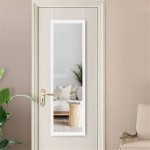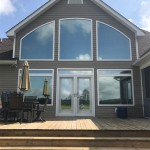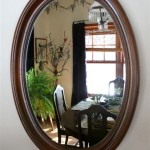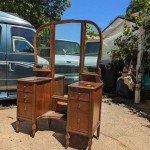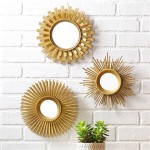Built-In Bathroom Mirror Cabinet: A Comprehensive Guide
The built-in bathroom mirror cabinet represents a functional and space-saving storage solution for bathrooms of all sizes. Integrating seamlessly into the wall, this type of cabinet combines the utility of a mirror with the practicality of hidden storage, maximizing available space and contributing to a tidier, more organized bathroom environment. This article examines the advantages, considerations, installation nuances, and maintenance aspects of built-in bathroom mirror cabinets.
Advantages of Built-In Bathroom Mirror Cabinets
One of the primary advantages of a built-in bathroom mirror cabinet lies in its space-saving design. By recessing into the wall cavity, the cabinet minimizes its projection into the bathroom, making it an ideal choice for smaller bathrooms where maximizing floor space is paramount. Unlike surface-mounted cabinets that encroach into the room, a built-in cabinet maintains a flush profile, creating a more open and spacious feel.
Furthermore, the integrated design promotes a clean and minimalist aesthetic. Concealing toiletries and personal care items behind mirrored doors contributes to a clutter-free countertop, enhancing the overall visual appeal of the bathroom. The seamless integration of the cabinet into the wall creates a streamlined look, aligning with modern design principles that emphasize simplicity and functionality.
Beyond aesthetics, built-in mirror cabinets offer enhanced storage capacity compared to simple mirrors or traditional wall-mounted cabinets. The recessing nature allows for deeper shelves and more vertical storage, accommodating a wider range of items. Adjustable shelves further enhance storage versatility, allowing customization to suit specific needs and item sizes. This increased storage capacity helps declutter countertops and drawers, contributing to a more organized and efficient bathroom space.
Finally, built-in mirror cabinets often contribute to enhanced safety, especially in households with young children. By recessing the cabinet into the wall, sharp corners and protruding edges are minimized, reducing the risk of accidental bumps and injuries. This design consideration enhances the overall safety of the bathroom environment, particularly for families with small children.
Key Considerations Before Installation
Prior to installing a built-in bathroom mirror cabinet, several crucial factors demand careful consideration. Foremost among these is the structural integrity of the wall. The wall chosen for installation must be capable of supporting the weight of the cabinet, both empty and when fully loaded with items. Load-bearing walls may require specialized reinforcement to ensure structural stability. Consulting with a qualified structural engineer or contractor is advisable, particularly when dealing with older homes or walls with uncertain construction.
Another critical aspect is the presence of electrical wiring and plumbing within the wall cavity. Before commencing any cutting or drilling, a thorough inspection of the wall's interior is necessary to identify and avoid damaging any existing utilities. Using stud finders and potentially consulting with a qualified electrician or plumber is crucial to prevent potentially hazardous and costly mistakes. Relocating any obstructions, if present, should be carried out by qualified professionals to ensure compliance with local building codes and safety regulations.
Furthermore, the dimensions of the cabinet and the available space within the wall cavity must be carefully measured and assessed. The depth of the cabinet must be compatible with the wall's thickness, and sufficient clearance should be provided around the cabinet to allow for proper installation and operation of the door hinges. Precise measurements are essential to ensure a flush and seamless fit. A slight miscalculation can result in installation difficulties and compromise the aesthetic appeal of the finished product.
The desired style and functionality of the cabinet itself are also important considerations. Features such as adjustable shelves, integrated lighting, electrical outlets, and defogging mirrors can significantly enhance the user experience. The style of the cabinet should complement the overall design of the bathroom, and the material should be durable and moisture-resistant to withstand the humid bathroom environment. Researching available options and selecting a cabinet that meets specific needs and preferences is crucial for long-term satisfaction.
Finally, local building codes and regulations must be taken into account before undertaking any installation work. Some jurisdictions may require permits for certain types of renovations, and compliance with electrical and plumbing codes is mandatory. Failing to adhere to these regulations can result in fines and delays. Consulting with local building officials or a qualified contractor can help ensure that the installation complies with all applicable requirements.
Installation Process and Best Practices
The installation of a built-in bathroom mirror cabinet is a multi-step process that requires precision and attention to detail. While some experienced homeowners may attempt a DIY installation, it is generally recommended to engage a qualified contractor for optimal results and to ensure compliance with safety standards. The process typically begins with marking the desired location of the cabinet on the wall and carefully cutting an opening in the drywall or plaster to accommodate the cabinet's recessed portion.
The framing of the opening is a critical step. Constructing a sturdy frame within the wall cavity provides structural support for the cabinet and ensures a secure and level installation. The frame should be constructed from durable lumber, such as two-by-fours, and securely fastened to the existing wall studs. Precise measurements are essential to ensure that the frame is perfectly aligned and square. Any deviations from squareness can result in installation difficulties and a misaligned cabinet.
Once the frame is in place, the cabinet can be inserted into the opening. Before securing the cabinet, it is crucial to ensure that it is perfectly level and flush with the wall surface. Shims can be used to make minor adjustments and compensate for any imperfections in the wall or frame. Securing the cabinet to the frame is typically achieved using screws or nails, ensuring that the cabinet is firmly anchored and stable.
After the cabinet is securely installed, the surrounding gaps between the cabinet and the wall must be filled and finished. Applying joint compound to cover the seams creates a seamless transition between the cabinet and the wall surface. Sanding the joint compound smooth and painting it to match the wall color completes the installation process. A clean and professionally finished installation enhances the aesthetic appeal of the bathroom and contributes to a polished and refined look.
If the cabinet includes integrated lighting or electrical outlets, the electrical wiring must be properly connected by a qualified electrician. Following all electrical codes and safety regulations is paramount to prevent electrical hazards and ensure the safe operation of the lighting fixtures and outlets. Improper wiring can create a fire hazard and void any warranties on the electrical components.
Maintenance and Longevity Considerations
Maintaining a built-in bathroom mirror cabinet is essential to prolong its lifespan and preserve its aesthetic appeal. Regularly cleaning the mirrored surface with a glass cleaner helps remove fingerprints, water spots, and other blemishes, ensuring a clear and reflective surface. Avoid using abrasive cleaners or harsh chemicals, as these can damage the mirror's coating. A soft cloth or sponge is recommended for gentle cleaning.
The interior of the cabinet should also be cleaned periodically to prevent the buildup of dust, grime, and mildew. Wiping down the shelves and interior surfaces with a damp cloth and a mild detergent helps maintain a clean and hygienic storage environment. Good ventilation in the bathroom is crucial to minimize moisture buildup, which can contribute to mildew growth.
The hinges and hardware of the cabinet should be inspected periodically for any signs of wear or corrosion. Lubricating the hinges with a silicone-based lubricant helps ensure smooth and quiet operation. Replacing any damaged or worn hardware can prevent further deterioration and maintain the functionality of the cabinet.
Addressing any water leaks promptly is essential to prevent water damage to the cabinet and the surrounding wall. Water leaks can cause swelling, warping, and mold growth, which can compromise the structural integrity of the cabinet and create unhealthy living conditions. Inspecting the plumbing fixtures and connections regularly and repairing any leaks promptly can prevent costly repairs and maintain the longevity of the cabinet.
Finally, avoiding overloading the shelves with excessive weight is important to prevent sagging or damage to the cabinet's structure. Distributing the weight evenly across the shelves and avoiding stacking heavy items on top of each other can help prolong the lifespan of the cabinet and maintain its structural integrity.

Bathroom Mirror Cabinets

Custom Designed This Medicine Cabinet To Be Recessed In A Built 1½ Inch Bathroom Mirror Glass Shower Enclosures Dining Room Wainscoting

Built Into Wall Bathroom Cabinets Recessed

My View Now Built In Mirror Cabinet Rectangle A4561200 Villeroy Boch

Built Into Wall Bathroom Cabinets Recessed

Should You Put The Medicine Cabinet On Bathroom Wall Or In It Houzz

Narrow Medicine Cabinet Foter Traditional Bathroom Designs Mirror

My View Now Built In Mirror Cabinet Rectangle A4561200 Villeroy Boch

48 In W X 30 H Rectangular Gold Aluminum Medicine Cabinets With Mirror Led Lighted Bathroom Cabinet Zt D0102h20mwv The Home Depot

Decoraport 48 X 32 Inch Led Double Door Smart Mirror Cabinet Touch Switch Anti Fog Dimmable Light Tri Color Memory Function Clock Display Built In Sensor Socket Usb Port G105 4832 Usa



